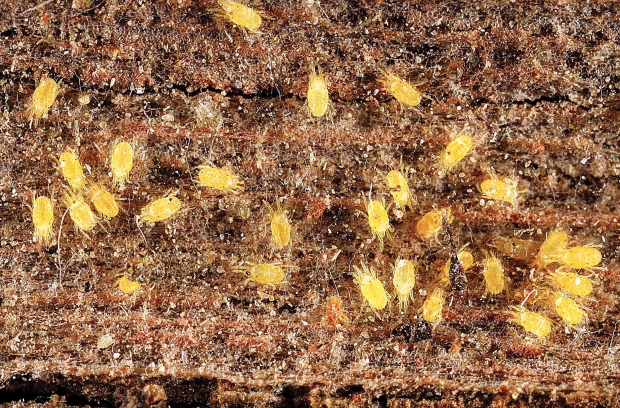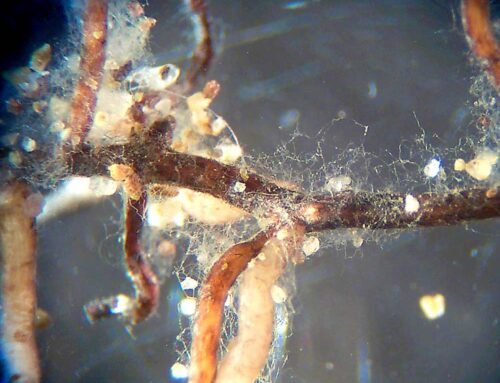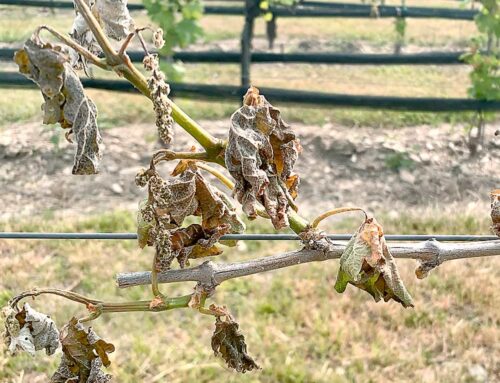
Willamette spider mites are pale yellow in color and prefer the cooler, shady parts of grapevines. (Courtesy of David James, WSU)
A survey of spider mite populations in Washington State vineyards last year revealed that, for the most part, spider mites are not an economic problem for growers and are being controlled by beneficial arthropods. But the survey confirmed a new spider mite species in the state.
Until last summer, it was believed that only a few spider mite species with an appetite for grapes were residents in Washington—two-spotted spider mite, McDaniel spider mite, bud mite, and rust mite. But in a survey of more than 25 vineyards last year, Willamette spider mite was detected for the first time in Washington.
The species was found in a vineyard on Red Mountain near Benton City, a region noted for hot summer temperatures. Willamette mite was previously identified in a Walla Walla Valley vineyard located on the Oregon side of the valley.
“We knew about the Walla Walla Valley vineyard detection, and the grower had been spraying for the mite for a season or two,” said Dr. David James, Washington State University entomologist.
“But Willamette spider mite had not been recorded before in Washington grapes. The Red Mountain find was a surprise,” he said, adding that the species is known to reside in cooler, coastal climates, like Oregon’s Willamette Valley and northern California. “We thought it unlikely it would turn up in the Columbia Basin. We didn’t expect to find it in a hot region like Red Mountain.”
He suspects that it has adapted to warmer temperatures. In both locations, the mite appears to be doing quite well.
Detection of a new mite species is no reason to panic, James said. “Willamette spider mite is less of a problem than two-spotted spider mite because it doesn’t seem to do as much damage in large numbers as two-spotted.”
Don’t panic
He noted that in California, some growers encourage Willamette spider mite outbreaks early in the season because it allows the plant to toughen up and better fend off mites later in the season.
“I’d put it in the same category as bud and rust mites,” he said to Good Fruit Grower. “It can be a problem but shouldn’t be the scare that two-spotted spider mite brings.”
But it is more than just a curiosity.
“If it has adapted to our climate, it could go on to become a problem,” James said. That’s why he’s expanding his research this summer to learn more about the newcomer.
James has been funded by the Wine Advisory Committee, the research arm of the Washington Wine Commission, to expand his spider mite work from last year and do another comprehensive vineyard survey this summer.
He is also working in the laboratory this season to learn about the life cycle of Willamette spider mite under Washington conditions. His project includes lab experiments for side-by-side comparisons of Willamette spider mite collected from Washington vineyards with those from cooler regions.
“We need to know if it has truly adapted and changed its tolerance to high and low temperatures. Or maybe, it’s just an ephemeral thing,” he said.
James will also be looking for effects of predator control of Willamette spider mite. Willamette spider mite is yellow and paler than the two-spotted mite, which is easily recognizable by its two dots.
He encourages growers to contact him if they think they have Willamette spider mite in their vineyard.
Minor issue
James believes that growers should be able to treat Willamette mite as any other spider mite. Generally, spider mite population levels in Washington wine grape vineyards do not warrant treatment. In California, where Willamette mite is common, it’s not been a problem, he said.
“At worst, Willamette spider mite can make grapevine leaves turn brown, but it shouldn’t impact yields or damage the crop, unlike bud and rust mites,” he said, adding that if bud and rust mites go undetected, they can cause crop loss and shoot dieback.
“Willamette spider mite should be a minor issue,” he said. But he cautions that if Willamette mite is found to be more widespread throughout the state, management guidelines may need to be developed.
Treatment
Growers are advised to avoid using pyrethroid insecticides for any spider mite infestations because pyrethroids can cause mite populations to flare, creating a worse problem than before treatment, the WSU researcher emphasized.
He is also concerned about another class of insecticides that could flare spider mite populations—neonicotinoids.
Of the vineyards in last year’s survey, only one had an economic spider mite problem, which appeared to be linked
to repeated use of imidacloprid, a broad-spectrum neonicotinoid. The grower had been using the neonicotinoid to control grape mealybug, a vector of grapevine leafroll associated disease.
In previous research, James found that imidacloprid acted as a “fertility drug” on two-spotted spider mite, significantly boosting egg production. Females fed leaves that had been sprayed with imidacloprid produced about 50 percent more progeny in their lifetime than two-spotted females fed leaves sprayed with water.
“That can be pretty significant when you consider that most of the spider mite population is female,” he said.
Females kept on the systemically treated leaves also lived longer than those in the water treatment group. The boost in reproduction was particularly evident in hops, a crop that James has studied extensively.
Further study of other neonicotinoids and their effect on spider mites is warranted, he added.
Survey
When James arrived from Australia in 1999 to join WSU, he found that grape growers were routinely using broad-spectrum insecticides like Lorsban (chlorpyrifos) and Sevin (carbaryl). Many of the pest issues then were chemically induced, he said. “Today, grape growers have made great strides in integrated pest management and have dramatically reduced their chemical use.”
Though he conducted a similar spider mite survey more than a decade ago, he says a new survey was warranted because of the change in pest management practices. Predatory mites were found in 60 percent of the samples in last year’s survey.
By using a free, volunteer workforce at the Washington State Penitentiary in Walla Walla to count the mites on leaf samples, James was able stretch research dollars and minimize costs to the grape industry. He is using the inmates again this season as part of his expanded mite survey. •
———-
What growers can do:
Growers are asked to report suspected sightings of Willamette spider mites to Dr. David James so he can better assess distribution and adaptation to Washington’s climate. He can be contacted by phone (509) 786-9280 or e-mail: david_james@wsu.edu.






Leave A Comment